Why Chuck Schumer Should Fear the Election of Alexandria Ocasio-Cortez
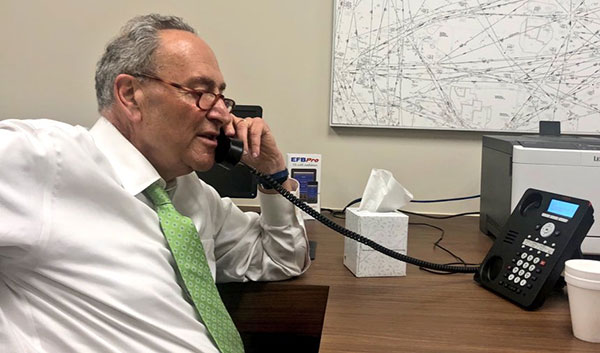
Senator Schumer on a tele-town hall (photo: @SenSchumer)
Pay heed Chuck Schumer. The base is coming for you.
And for good reason. The Democratic establishment is historically unpopular. And there is no exception even in deep blue New York.
Alexandria Ocasio-Cortez’s resounding defeat of Rep. Joe Crowley, the so-called King of the Queens machine, makes clear that establishment Democrats need to wake up. The election of an overnight socialist sensation was a clear demonstration that the groundswell of grassroots progressive activism in New York has moved from street protests to the voting booth.
Ever since Democrats lost to the least qualified presidential candidate in the history of the republic in 2016, there has been a growing repulsion with the status quo on the left across the country generally and in New York City specifically.
Soon after Donald Trump took office, progressive activists took to protesting Senator Schumer outside his Park Slope home. Disgusted by his admitted willingness to work with the demagogue-in-chief, progressive activist groups like Indivisible Nation BK, of which I am a board member, braved the cold winter months to deliver a message: Donald Trump is a racist, xenophobic, treasonous existential threat to the nation and the world. And we want our senators, particularly the Senate minority leader, to say that loud and clear.
Senator Schumer would be wise not to take the base for granted. Just this month, members of Indivisible Nation BK gathered to hear him address his first town hall since Trump’s election. The event was the culmination of over a year of protests, pushing, and prodding by our group and others. However, the senator abruptly altered the event a mere 90 minutes before it was supposed to start. Apparently dealing with plane trouble, Senator Schumer told us he was stuck at an airport in Utica and would conduct a tele-town hall instead.
We were not impressed. As we anxiously waited for the opportunity to ask him how he would save our country, we listened in disbelief as the senator launched into a monologue about how he played basketball in high school and then got into Harvard.
We do not need a regurgitation of the senator’s well-known biography. What we need is leadership. As one tele-town hall participant put it, it’s like we are playing a basketball game, and while Democrats are practicing their bounce passes, Republicans are cutting players’ throats on the court.
Meanwhile, Trump is about to shape the Supreme Court for a generation. Incredibly, if you listened only to Sen. Schumer talk about the matter, you would never know that Trump is poised to do so while under federal investigation for obstruction of justice after his campaign blatantly and wantonly courted a hostile foreign adversary to swing his election. Just last week, Trump stood, quite literally, shoulder-to-shoulder with Vladimir Putin in rejecting his own intelligence community’s conclusion that Russia interfered in the 2016 presidential campaign. Why is Chuck Schumer not taking every opportunity to call Trump an illegitimate traitor when talking about the Supreme Court fight? What weakness.
If Senator Schumer cannot whip his entire caucus to vote against any nominee not named Merrick Garland, then he should step aside as minority leader. Such a failure would further demonstrate what is becoming readily apparent: that Senator Schumer is not the leader for this dire hour. What we need is a progressive firebrand to lead the charge and throw as many wrenches into the machinery of corruption as possible.
We cannot compromise with the Republican Party. That is because there no longer is a Republican Party. It has been replaced by a reactionary white nationalist party masquerading as the Republican Party, beholden to only Trump. And there can be no compromise with what is dead and rotting. We expect our leaders to adopt a war footing, because, have no doubt, we are at war for the soul of our nation.
A war footing also means supporting bold and clear progressive policies such as Medicare-for-all, federal jobs and affordable housing guarantees, paid parental leave, and tuition-free public universities. When so-called “pragmatic” Democrats inevitably and facetiously ask us how we plan to pay for it, let us be equally resolute in our reply: by taxing corporations, millionaires, and billionaires. No more 12-point plans and carefully crafted, round table-produced cookie cutter messaging.
These progressive policies are overwhelmingly popular both nationally and in New York. This is why, for example, bold progressive policies have been the cornerstones of Cynthia Nixon’s campaign for governor against the comically establishment Andrew Cuomo. And it is also why Cuomo has been moving to the left as quickly as possible ever since Nixon announced her running.
Half-measures are no longer sufficient. New York’s Democratic voters expect our Democratic officials to bleed blue like us. They must be both moral authorities and fearless leaders.
So pay attention and take action, Senator Schumer. We are.
***
Steve Wagner is a Brooklyn-based activist and personal injury trial lawyer. He is an executive board member of Indivisible Nation BK. He blogs at brooklynresists.nyc. On Twitter @stevedwagner.
***
Have an op-ed idea or submission for Gotham Gazette? Email This email address is being protected from spambots. You need JavaScript enabled to view it.
We Need Commercial Waste Reform, and Now We Have a Plan
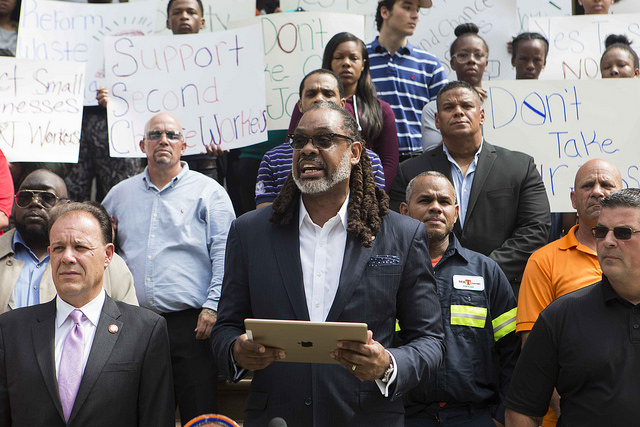
Council Member Cornegy, the author (photo: Emil Cohen/City Council)
New Yorkers have good reason to be concerned, even angry, about the state of affairs in our city's commercial waste industry. Stakeholders and commentators are absolutely right to note that, among other issues to address, the tragic loss of life in this industry is unacceptable.
However, agreement on the importance of cleaning up commercial waste carting does not change the fact that a huge question is still on the table: How can we actually achieve our shared goals as quickly and effectively as possible?
In many ways, the answer lies in comments made just this week by Mayor de Blasio, when he said, "I hope that we can really strengthen the hand of the Business Integrity Commission, give them a lot more tools, a lot more teeth to work with in their regulation of that industry."
My colleagues in the City Council and I have introduced legislation, known as Intro. 996, which would do that by empowering the Business Integrity Commission (BIC) to raise standards in the commercial waste industry and hold bad actors accountable.
Our bill would enable BIC to create standardized safety certifications for industry employees and institute requirements that ensure workers are properly trained. It would also give BIC the tools to establish clear rules regarding allowable levels of emissions for commercial waste trucks. Additionally, the bill would empower BIC to more stringently regulate the industry with regard to maximizing efficiency along each waste collection route.
These are just several examples of how Intro. 996 would give BIC more of the tools and teeth that Mayor de Blasio has said are necessary for advancing commercial waste carting reforms. Our legislation would also let BIC establish its own task force to offer additional insight and recommendations for continuing to improve this industry over the long-term.
On the other hand, Mayor de Blasio's own Department of Sanitation has offered a nebulous and flawed proposal to develop commercial waste zones, which would replace the industry's current open market system with a series of geographic zones that are exclusively contracted to a small number of waste carters.
First, Sanitation’s proposal is not squarely focused on advancing the mayor's stated goal of empowering BIC. By relying on a fundamental restructuring of the industry, this plan would essentially take power away from BIC rather than giving it more of the tools it needs to regulate carting companies.
There is also the issue of unintended consequences. It is common knowledge by now that the zone-based waste collection plan implemented last year in Los Angeles had a truly disastrous rollout. Prices and service complaints skyrocketed, leading to a chaotic situation that, if it were to happen in New York, would surely make it extremely difficult to achieve our shared goals.
The Department of Sanitation’s own 2016 report, released as part of introducing its waste zone proposal, acknowledged that costs for small businesses that are served by this industry would increase under a zone-based plan. Additionally, the report acknowledged that zones would lead to job losses in the industry - and I do not think that efforts to increase safety have to include putting people out of work.
To be clear, I am ready to advance commercial waste carting reforms now and deliver results on increasing safety, reducing environmental impact and increasing regulatory oversight. And I want to achieve this in the way that Mayor de Blasio himself has articulated - by giving BIC more of the tools and teeth it needs.
Now is the time to translate our concerns about this industry into tangible, sensible, and effective action - we just need to get it done.
***
Robert E. Cornegy, Jr. represents the central Brooklyn communities of Bedford Stuyvesant and northern Crown Heights in the New York City Council. On Twitter @RobertCornegyJr.
***
Have an op-ed idea or submission for Gotham Gazette? Email This email address is being protected from spambots. You need JavaScript enabled to view it.
I’m with Cynthia Because She Stands for Schools, Not Jails
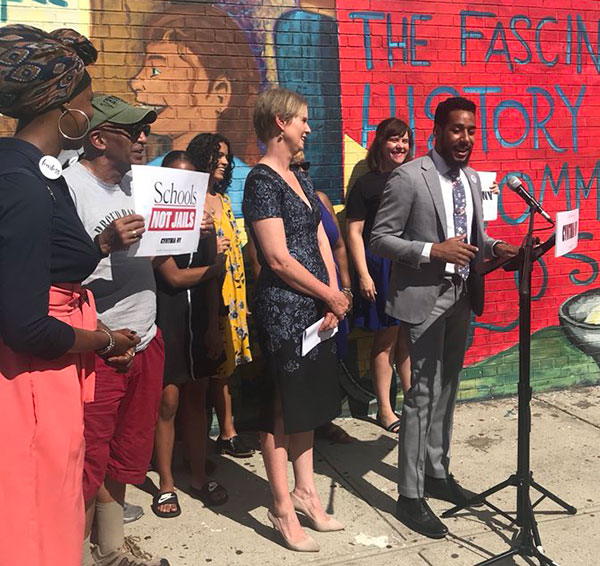
Antonio Reynoso, the author, endorses Cynthia Nixon (photo: @CMReynoso34)
Last week, I endorsed Cynthia Nixon for Governor because her campaign is focused on making sure young people of color across New York thrive in school, rather than wither away in jail. As a City Council member from a predominantly black and brown community in Brooklyn, I constantly hear from young people who know what they need to succeed in school and what stands in their way.
Right now, there are more police in New York City schools than there are guidance counselors and social workers combined. What message does that send our children?
It is time to drastically change course in how we invest in the lives of black and brown young people. Talking to friends and allies across the state, the stories and experiences of the young people in my district are strikingly similar to those of young people across New York, from the Hudson Valley to Syracuse and beyond—because, while we can draw geographical lines to separate their school districts, it’s the color line that ensures they will all still be impacted by racially discriminatory school discipline policies and practices.
These policies have created a school-to-prison pipeline that afflicts young people of color across the State of New York. As Governor, Cynthia Nixon is committed to transformative policy changes to dismantle this system. That’s why a central part of her #SchoolsNotJails platform is school climate reform. Cynthia’s plan will push New York to lead the way by creating a Restorative Practices Training department within the State Department of Education to support schools in implementing restorative practices, introduce legislation to end school-based arrests for misdemeanors and violations, support schools to remove ineffective security measures, such as law enforcement and metal detectors, and only use suspensions as a last resort.
In New York State, there are over 500 suspensions per day and a disproportionate number of our young people being suspended are students of color. Statewide, one in five black boys are suspended from school each year; for black girls, it is one in seven. In New York City, black students are 27% of the population but nearly half of all students suspended; in Kingston they are 14% of the student body but 36% of all suspensions; and in Troy, they are 31% of the population but 61% of all students who are expelled.
The racial disparities in the statistics on referrals to law enforcement are just as alarming. In New York City, black and Latino students are 92% of all students who receive a summons; in Schenectady, black and Latino students are 75% of all students referred to law enforcement; and in Buffalo, black and Latino students are 85% of all students referred to law enforcement.
These disparities begin in pre-kindergarten, where black students are 3.6 times more likely to be suspended from school. And they continue through high school and beyond—one suspension in high school doubles the likelihood that a student will drop out before graduation and it denies students from critical instructional time. Last year, students in New York lost 686,000 days of instruction because of suspension. If the school discipline gap continues, it’s no wonder that our state is struggling to close the graduation gap.
Those numbers alone should be enough evidence to convince Governor Cuomo to take steps to dismantle the school-to-prison pipeline. But instead of confronting this reality, under his leadership, New York has done nothing to curtail the school-to-prison pipeline.
The young people I meet with are clear that the way forward is not to continue to “harden” their schools and rely on ineffective and harsh school discipline and policing, but to ensure equity in school discipline policies and practices and reimagine our approach to safety. There is no evidence that police officers and metal detectors make schools any safer, but there is ample research that shows they makes students feel less safe and result in more young people being pushed in front of police officers, prosecutors, and judges instead of guidance counselors, social workers, and school administrators.
Students feel safest in their schools not when they know technology exists that track their every move, or police officers do random checks and sweeps, but when they have staff trained in trauma-informed care, restorative practices, and youth development that are there to attend to their needs and create an inclusive environment.
Young people in my district are leading the way in demonstrating what safe and supportive schools can look like. Many of these schools are implementing restorative practices with real results -- dramatically decreasing suspensions and building strong school communities. This year my district saw one of the largest decreases in suspensions across the city. We can replicate this and transform schools into the safe and supportive learning environments our students and families deserve.
New York needs a public school system that is completely disentangled from the criminal justice system and a commitment that we are creating a nurturing and supportive environment for all students. This is the commitment that Cynthia Nixon is making. We need to invest in schools, not repeat the same policy failures that have led to our children ending up in jails.
***
Antonio Reynoso is the City Council member for New York’s 34th Council District in Brooklyn. On Twitter: @CMReynoso34.
***
Have an op-ed idea or submission for Gotham Gazette? Email This email address is being protected from spambots. You need JavaScript enabled to view it.
Fixing the City's Broken Approach to Nonprofit Contracting
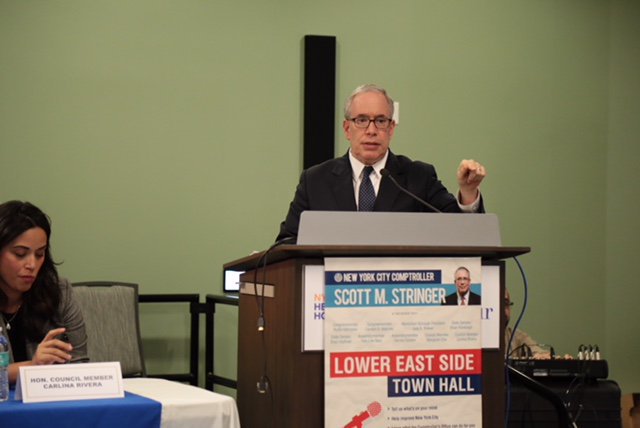
Comptroller Scott Stringer, a co-author (photo: @NYCComptroller)
From housing for homeless families to meals for our seniors, non-profit organizations are on the front lines of our city, supporting our most vulnerable neighbors. Yet these groups are surviving hand-to-mouth when it comes to funding and often it’s our own city government that’s stalling the contracting process and delaying payments that thousands of nonprofits rely on.
In a new report, New York City Comptroller Scott Stringer’s office looked at thousands of human service contracts, and found an astounding 90 percent were submitted to the Comptroller’s Office for registration by a City agency after the contract start date had already passed, with half of them arriving six or more months late. Some agencies, including the Department of Homeless Services and the Department of Education, submitted over 99% of their contracts late.
The consequences of the City’s chronic lateness are huge. Because vendors don’t get paid until their contracts are registered, widespread delays in the contracting process force cash-strapped nonprofits to take out loans, miss payroll, or potentially cut services, just to deal with the shortfall in cash. In the last fiscal year alone, nonprofits took 751 City-issued bridge loans worth $149.9 million in total to keep the wheels turning as the City slowly processed their contracts.
It’s unacceptable. The burden of the City’s sluggish procurement process shouldn’t fall on our non-profit partners. That’s why we’re calling for common-sense reforms to break through the bureaucracy.
The City should build a public tracking system for contracts. If you can track a package as it moves across continents, you should be able to track contracts as they move through City agencies. Moreover, the City must develop clear metrics and strict timeframes throughout the procurement process, which will bring a basic level of transparency and accountability into this system.
Consider this: a non-profit is awarded a City contract to provide job training, with a specific start date for summer programming. That contract then goes through multiple layers of bureaucracy at the contracting agency before going over to some, if not all, of the following oversight agencies for review: the Mayor’s Office of Contract Services, the Law Department, the Office of Management and Budget, the Department of Investigation, and the Division of Labor Services at the Department of Small Business Services.
These levels of review are crucial and help to safeguard the integrity of the City’s public procurement process, rooting out waste and fraud. But as these agencies are not held accountable to deadlines, the full process can take months or even years to complete before the contract arrives at the Comptroller’s Office for registration.
In the end, the non-profit is left waiting for its contract and subsequent payment, without information on the process. This forces hundreds of non-profits into an impossible catch-22: wait to begin work, which can stall vital services and drive up costs – and in reality is rarely possible – or begin work without a registered contract, which can jeopardize the organization’s finances.
But with strict time-frames and a tracking system, non-profits might be spared this turmoil and gain some control in a process that currently treats their ability to function and help thousands of New Yorkers as an afterthought.
What we’re putting forward is a blueprint for the City to do better. Making these fixes will bring the contracting process in line with the City’s priorities, because behind these contracts are people who need food to eat, a roof to sleep under, or someone to care for them. These people are our neighbors, our relatives, and our friends. And right now, the snail’s pace of City agencies is putting their care at risk.
***
Scott Stringer is New York City Comptroller and Jose (Joey) Ortiz, Jr., is the Executive Director of the NYC Employment and Training Coalition. On Twitter @NYCComptroller and & @JoeyOrtizJr of @NYCETC_org
***
Have an op-ed idea or submission for Gotham Gazette? Email This email address is being protected from spambots. You need JavaScript enabled to view it.
CUNY’s Turn to Provide Paid Parental Leave for All
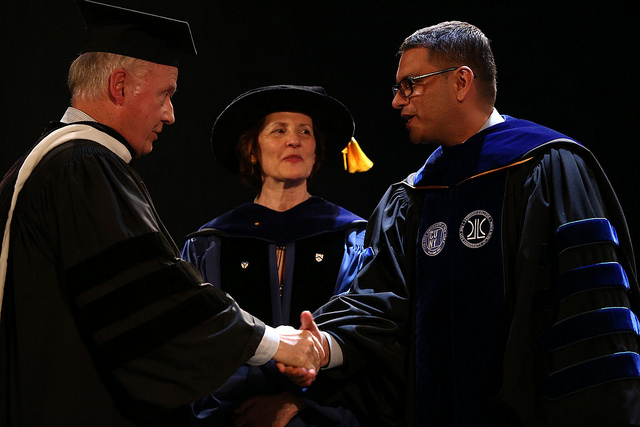
Macaulay Honors College commencement (photo via CUNY)
She hid her growing belly under loose dresses and oversized sweaters when she taught her classes of 30 college students. She avoided the departmental office during normal work hours, retrieving her mail early in the morning. If someone realized she was pregnant, she worried, some excuse would be found to deny her work for the next semester. With a baby on the way, losing her job would have put her and her spouse over the financial edge on which they delicately teetered.
Finally, after securing work, the adjunct faculty member relaxed and let her pregnancy show. Still, she worried about the due date. If there were complications, would she be able to return to work within a week as her employer required?
A story from a past generation? No. At CUNY, many adjunct faculty members – called “part-timers”– avoid telling their department chairs and colleagues about an impending pregnancy because their work is contingent from one semester to the next and they fear non-reappointment. Pregnancy discrimination is difficult to prove as adjuncts can be denied employment for any reason or no reason at all.
Even after that hurdle is successfully cleared, CUNY requires that a woman return to work a week after giving birth. Often, this is difficult for the mother and child. Sometimes, it is impossible. Then, she faces the peril of being unilaterally fired, losing her health benefits as well as her income just when she needs them most.
Sometimes co-workers willingly contribute unpaid labor to spell the new mother in the classroom and kindly administrators look the other way. But in many cases, it seems “easier” to find a new part-time faculty member to teach a class than to provide accommodations for the pregnant one. This discrimination arises from chronic understaffing, the well-worn trope of “interruption” to students’ education, and, especially, a pervasive attitude that, even though they teach more than half of all CUNY courses, adjuncts are seen as little more than the labor they provide.
CUNY still pointedly disavows any institutional responsibility to even long-time workers. Adjuncts don’t even have the right to “bank” unused sick days from one semester to the next, and the oddity of counting only their classroom hours as “work time” makes most ineligible for even the limited protections of the Family Medical Leave Act.
We are hopeful, though, that CUNY will soon see fit to enter the 21st century. Recently, two New York faculty unions, United Federation of Teachers and SUNY’s United University Professors, have won paid parental/caregiving leave for their members. And CUNY’s new interim chancellor, Vita Rabinowitz, is a renowned feminist scholar. While working at Hunter College, she was the founder of the Gender Equity Project, intended to clear away obstacles facing women faculty. At a recent Board of Trustees meeting, over a dozen adjuncts asked her to utilize a new state law as a vehicle for the kind of workplace justice she pioneered earlier in her career.
Under New York Paid Family Leave, workers pay a small supplement and receive partial pay and the right to return to their job for up to 12 weeks after childbirth, adoption, or to care for a sick family member. While private employers are required to implement the PFL, unfortunately, public employers, such as CUNY, can choose whether to opt in or not. So far, CUNY has failed to do so.
Currently, CUNY has over 15,000 “part-timers” who need relief from uncertainty. It’s time for their employer to provide this small modicum of security and stability. Then, paid family leave would make CUNY a place where pregnant women can proudly display their bellies for all the celebration that creating new life brings.
***
Pamela Stemberg is an adjunct lecturer teaching at CCNY and Hostos College. Marc Kagan is a graduate assistant teaching at Lehman College.
***
Have an op-ed idea or submission for Gotham Gazette? Email This email address is being protected from spambots. You need JavaScript enabled to view it.
In Crowded Office Market, Amenities are a Must
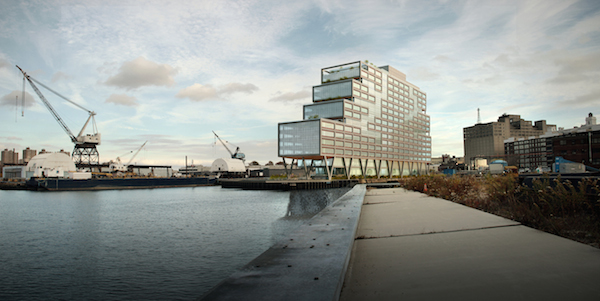
Dock 72 rendering
As New York’s economy continues to thrive, the city’s construction and real estate industries are enjoying a sustained building boom that is creating more than 2.5 million square feet of new office space each year. Even with this unprecedented growth, there is still an insatiable demand for new commercial space from companies new and old. To stand out in such a market, developers must create innovative offices filled with cutting-edge amenities – and this trend is reshaping commercial real estate in the five boroughs and beyond.
Amenities like roof decks and fitness centers have long been staples of luxury residential buildings. But more recently, developers and property owners have begun incorporating these perks into commercial office space as a way to attract new and younger tenants. This movement has only intensified in recent months as more and more young professionals and creative companies are drawn to New York City.
Ironically, the apex of this new trend in commercial real estate can be found at one of the City’s oldest facilities: the Brooklyn Navy Yard. Thanks to almost $1 billion of public and private investment, the Navy Yard is in the midst of its largest expansion since the Second World War. The Navy Yard is poised to add 10,000 jobs across two million square feet of new space, in part because that space is optimized to attract the types of companies and talent driven by innovation.
A centerpiece of the Navy Yard’s expansion is the new high performance office building, Dock 72, on which our firms, Boston Properties and Rudin Development, and our anchor tenant, WeWork, have partnered to provide commercial tenants with world-class amenities, sustainable design, and state-of-the-art technology.
Our vision for Dock 72 has been to create a next generation waterfront workplace, where tenants and their employees can collaborate and connect with their coworkers and neighbors. That is why our team is collaborating with WeWork to create a truly unforgettable workplace environment, generated with the well-being of tenants in mind.
When completed later this year, Dock 72 will offer tenants multiple organic food, beverage, and coffee options; an outdoor basketball court and a full-service fitness complex; and a rooftop conference center, event space, an open lawn, and terraces with breathtaking views of the surrounding Navy Yard, the East River, and Manhattan. These amenities were curated by WeWork, based on the best practices they’ve developed while attracting innovative companies in cities around the world. They’re just a few of the reasons why tenants of Dock 72 will enjoy one of the best work experiences in New York City.
Landlords and developers know that it isn’t enough to just offer modern office space – the recent boom in commercial construction means that potential tenants have a wide-variety of options to choose from. That’s why companies like ours will continue pushing the boundaries and coming up with new, state-of-the-art amenities.
This is good for New York City. Businesses that locate in innovative new spaces like Dock 72 will have happier and healthier employees, which will in-turn make them more productive. This creates a virtuous cycle that will keep our city a vibrant and prosperous economic hub for decades to come.
***
Michael Rudin is a Senior Vice President at Rudin Management Company and Andrew Levin is Senior Vice President of Leasing-New York of Boston Properties.
***
Have an op-ed idea or submission for Gotham Gazette? Email This email address is being protected from spambots. You need JavaScript enabled to view it.
City Leaders Say They Stand with Muslims & Immigrants, But Do They Mean it?
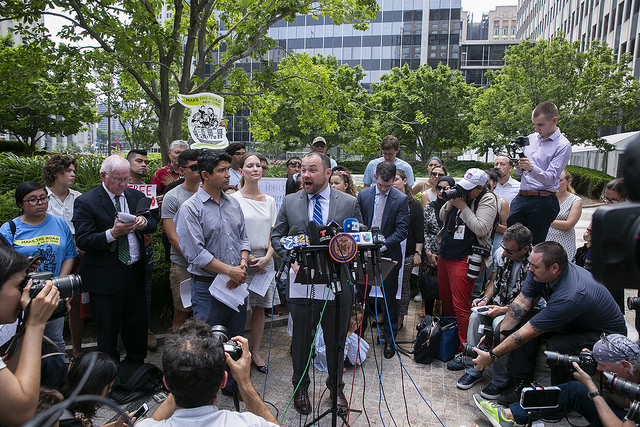
(photo: William Alatriste/City Council)
New York City’s leaders have recently been protesting with Muslim and immigrant New Yorkers, but these same leaders are often missing once the cameras are gone. After last week’s stunning Supreme Court setback, the time finally has come for these same leaders to ditch New York City’s anti-Muslim and anti-immigrant police policies.
We clearly say we’re a sanctuary city, but the facts on the ground are unclear. No, city workers can’t ask about immigration status, but NYPD officers continue to use dragnet surveillance on immigrant communities. Most importantly, they continue to share that data with Immigration and Customs Enforcement (ICE), which the Trump administration is using to intensify its deportation efforts.
Every day, license plate readers all across New York City monitor cars in real-time. These cameras create a massive database of our movements across the city. But instead of using this database just to do police work, the NYPD shares the data with private, for-profit firms like Vigilant Solutions, a company that struck a deal to share New York data with ICE earlier this year.
But the license plate readers aren’t even the worst part. At least the City told us about them. All-too-often, we only find out about spy tools after they’ve been used for years. Tools like stingrays, fake cell towers that can suck-up all the phone data for miles around. To target one suspect, stingrays often need to track thousands of phones. Worst of all, the NYPD has even used these devices without a warrant. Wondering if your texts or calls were copied before? There’s no way to tell.
The City Council knows about the problem now – we told them about it – but for years this spying went on in secret. How? The NYPD has a slush fund: millions in federal and private dollars that can be spent without any oversight by the City Council. The mayor could end this tomorrow; Mr. de Blasio could require the NYPD to disclose how its spy data is shared with ICE with the stroke of a pen. But I’m not holding my breath.
Instead, we need the City Council to act. For years, CAIR-NY, NYCLU, and other advocates have pushed the POST Act, a commonsense bill that would require the NYPD to tell our lawmakers what military-grade spy gear they’re buying with private and federal dollars and how they’re keeping that information safe. The NYPD could continue surveillance, but the cowboy-era of buying whatever it wanted, whenever it wanted would be over. More importantly, the NYPD would finally enact policies to make sure our city’s resources won’t help ICE deport our neighbors.
But, the bill has stalled.
Our city’s leaders have long promised to make New York a sanctuary for all—a symbol of inclusion at a moment of presidential prejudice. So far, action has fallen short of soaring rhetoric, but that can change. This is the moment for our city to practice what we preach. This is the moment to prove we can do more than just show up for the protest.
***
Albert Fox Cahn is the Legal Director of the Council on American-Islamic Relations, New York, a leading Muslim civil rights organization. On Twitter @CahnLawNY and @CAIRNewYork.
***
Have an op-ed idea or submission for Gotham Gazette? Email This email address is being protected from spambots. You need JavaScript enabled to view it.
From Awareness to Action: Combating The Epidemic of Gun Violence
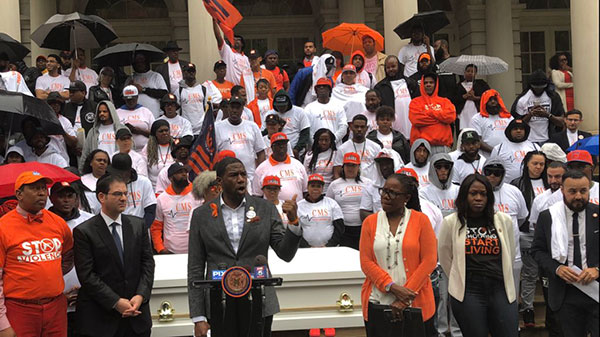
Jumaane Williams, co-author, center (photo: @JumaaneWilliams)
Throughout June, we observed Gun Violence Awareness Month. In the year since we last marked this occasion, 33,000 people lost their lives to gun violence in this country. A mass shooting of four or more casualties occurred nearly every day of that year, and just last week, five people were killed and two injured as a shooter opened fire on an Annapolis newsroom. Over the course of the month about 3,000 people were killed. Over 200 were children.
The statistics are staggering, but at the same time, we have come, over time, to acknowledge and accept this carnage as part of American life. No one can deny it -- we are, in fact, well aware of the plague of gun violence in America.
Yet while this past year has seen death and heartbreak on a massive scale, it has also been marked by a heightened, sustained awareness of the problem that extends beyond the headlines and the evening news. More than many previous years, the horrors and the causes of gun violence in this country have been spotlighted and a central part of the public consciousness. School walkouts and the March for Our Lives, driven by young people across the country, have made it clear that awareness itself is insufficient. We must continue to use this moment to propel awareness into action.
This action, of course, can take many forms. People can use their votes to demand representatives who will stand up to the NRA and other special interests, to fight for common sense gun safety measures. People have the power to make gun reform—not lip service, but real progress—a defining issue of this year’s elections. To make elected officials aware that thoughts, prayers, and passive support are not enough.
Shootings permeate every area of American life -- from churches and schools to concerts and workplaces. The vast majority of gun violence deaths, though, still stems from the daily plague of gun violence in our streets. This is the form of violence that often evades the national consciousness, but is devastating to communities.
This week, as the nation celebrates the Fourth of July, historical trends would suggest that on the ground, in certain neighborhoods, gun violence and the devastation it causes will increase. At odds with the air of celebration, this is a sobering reminder that awareness alone does not create solutions. Much of the recent awareness and attention has rightly been directed at the volume of firearms entering communities. While the availability of guns is one side of the problem we also have to consider why people use them.
Gun violence is a crisis with roots in social-structural inequality, economic distress, trauma, behavioral and public health, and when it is treated as such, we can stop the spread of the disease and combat it at its core. In cities like New York, black men are 13 times more likely to be killed in an act of gun violence than their white counterparts. These wounds—despite rarely making national news—leave a history of trauma in low-income communities of color.
And in New York City, we are relying on community to lead, activating what is known as the Crisis Management System. The Crisis Management System is a network of 50 community-based organizations attached to sites throughout the five boroughs that focus on violence interruption. The organizations employ people who have experienced many of the same things as the young people most at risk, and these violence interrupters identify and intervene in conflicts before they escalate into bloodshed. Recognizing that violence is exacerbated by social stressors, these interventions include additional supports such as job training programs, mental health services, legal aid, hospital responder programs, links to institutions of higher education, and art programming.
The approach is working.
In 2017, the city saw its lowest rates of violence since the 1950s, with a significantly greater drop in areas targeted by Cure Violence than the citywide average. There is much work to be done, but these successes show that with meaningful investment of energy and resources, violence can be prevented and lives saved.
As Congress refuses to take up the fight to end gun violence, community activists and their organizations are on the streets, effecting vital, incremental change. Just as Americans must continue to push their representatives in Congress toward gun violence solutions, they need also to work within their towns and cities to support local voices, groups, and movements, to demand the kind of reforms that we know can have a meaningful impact on the pervasive epidemic that is gun violence.
We are aware of gun violence. When not in our streets it is on our screens, America’s most predictable tragedy. This heightened awareness, raised by the wave of activism against gun violence that has swept over the country since the Parkland shooting, could too easily turn into numbness and complacency. It is imperative that we continue to feel each act of senseless violence, and work to prevent the next, moving past the month of June and carrying throughout the entire year.
***
Jumaane D. Williams is a City Council member from Brooklyn and Eric Cumberbatch is the executive director of the Mayor's Office to Prevent Gun Violence. On Twitter @JumaaneWilliams and @NYCMayorsOffice.
***
Have an op-ed idea or submission for Gotham Gazette? Email This email address is being protected from spambots. You need JavaScript enabled to view it.
Amid Crisis, A Promising Model for NYCHA
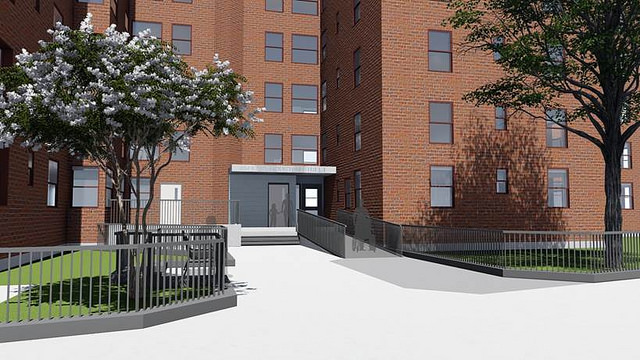
(image via NYCHA)
Recently, there has been a great deal of attention paid to the deterioration of New York City’s public housing stock and the plight of families living in New York City Housing Authority (NYCHA) developments. We’ve seen a vigorous debate over how we got here, who is responsible, and who should control NYCHA going forward. While headlines surrounding NYCHA have been overwhelmingly negative, there is good news that illustrates the promise of better quality of life for NYCHA tenants.
Last week, the Citizens Housing & Planning Council (CHPC), a nonprofit civic research organization, released an interim report from a study on an innovative pilot program that began in December 2014. The pilot shifted management of six Section 8 properties located in the Bronx, Brooklyn, and Manhattan, to Triborough Preservation Partners, a joint venture between NYCHA, L+M Development Partners, and BFC Partners.
The transaction made available $80 million in new capital funds for renovations at buildings containing 874 units and introduced new property management. This money went towards new boilers and elevators; making buildings and units more energy efficient; improving landscaping and common areas; new kitchens and bathrooms inside the apartments, and providing security upgrades. Importantly, no residents were displaced as these renovations occurred.
We evaluated the impact of the changes at these sites before and during construction, comparing them with a control group of six NYCHA developments of similar size and characteristics. Research included collecting data on repair requests, resident turnover, energy use, and rent collection, interviews with property management staff, as well as a tenant survey conducted in partnership with Baruch College Survey Research.
The word “privatization” is a grenade that gets thrown a lot in discussions of NYCHA and does not appear in our study. As a research organization, we will leave it to others to characterize this pilot program. But here are the facts: NYCHA retains 50% ownership. The rental assistance is paid for by a Section 8 contract funded by the federal government. The renovations, approximately $90,000 per unit, were funded primarily using Low Income Housing Tax Credits and Tax-Exempt Bonds from the New York City Housing Development Corporation. Both NYCHA and HDC retain the right to approve or deny any proposed sale of the property.
A private property management company (C+C management) is now responsible for day-to-day operations at the site. As a result of the renovations, the new management company is currently responding to only one-fifth as many repair requests. Electricity usage has gone down, and rent collection has improved. At the same time, turnover rose and re-rental time took longer.
The tenant survey determined that Triborough residents’ ratings of their housing surpassed those in the control group in almost every measure, with residents’ ratings of their own apartments, the overall building, and elevators outpacing NYCHA residents’ ratings by at least 2:1.
Not only did we see obvious, physical improvements in conditions at building sites, we saw how the improvements impacted the day-to-day lives of tenants – in their comfort, sense of safety, and how they felt about their homes and surroundings. Tenants, many of whom felt trepidation about this approach, have seen results and can see that their fears did not come to fruition.
For instance, residents felt safer (65% in the pilot group felt very safe, compared with 37% in the control group), that day-to-day management was responsive (86% in the pilot group, compared with 55% in the control group), and that emergency repairs were addressed (73% in the pilot group, compared with 47% in the control group). And, interestingly, residents in the pilot group were almost 30 percentage points more likely to recommend their building to a friend or family member.
Our findings were only the first, encouraging step; we plan to continue to collect and review more data during the post-construction period.
NYCHA faces a number of daunting challenges, illustrated by the report that came out Monday morning detailing the $31.8 billion that NYCHA needs over the next five years to address unmet capital repairs. Tackling these challenges alone would be impossible. Tough times call for innovative thinking, and the City should be commended for creating a structure that brings in new partners and new resources that ensure affordability and a set of incentives that has significantly improved the quality of life for residents.
***
Jessica Katz is executive director of the Citizens Housing & Planning Council. On Twitter @chpcny.
***
Have an op-ed idea or submission for Gotham Gazette? Email This email address is being protected from spambots. You need JavaScript enabled to view it.
The Upstate Economy and The Election for Governor
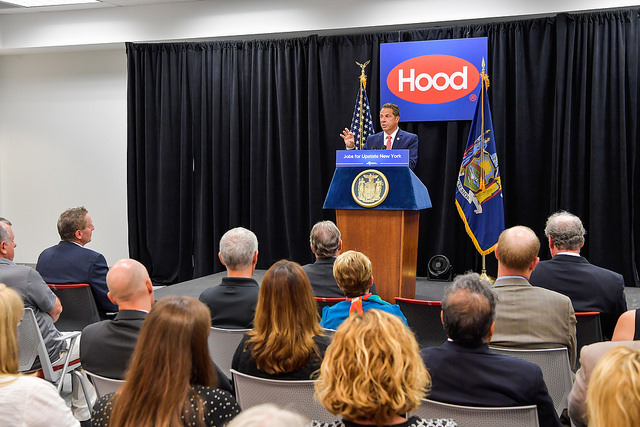
Gov. Cuomo touting Upstate jobs (photo: The Governor's Office)
The health of the Upstate New York economy is a major issue in this year’s election for Governor. Two candidates in the general election, Republican Marc Molinaro, the Dutchess County Executive, and Stephanie Miner, the former mayor of Syracuse, a Democrat planning to run on an independent line, hail from Upstate, and are already in part centering their campaigns on criticisms of state government’s efforts to help the Upstate economy. Governor Andrew Cuomo’s rival in the Democratic primary, Cynthia Nixon, is also making it a point of attack.
Ironically, a federal corruption trial is underway against former SUNY Polytechnic President Alain Kaloyeros, who had been given a mission and vast resources by Cuomo to stimulate growth in the Upstate economy.
The Upstate region is very politically significant in statewide elections. Although the region is 36% of the state population, it has been between 46 and 49% of the statewide vote in the last three gubernatorial elections, 2006, 2010, and 2014. By contrast, New York City has been 27-29% of the vote in these elections despite being 43% of the population. Upstate New York is considered to encompass all of New York except New York City, Long Island, and the City’s northern suburbs, including Westchester, Rockland, and Orange Counties.
The region is also economically significant. Upstate New York’s population is 7 million, larger than 33 states, and is one-third of total employment in the state. My two previous columns on the Upstate New York economy focused on growth during the first six years of Governor Cuomo’s tenure, through 2016, and then a longer view.
The first review last fall showed that Upstate New York employment only grew 3.3% in total overall jobs between 2010 and 2016, compared to 10% growth for New York State as a whole. The comparable numbers for private sector employment growth were 5.8% for Upstate, compared to 13% growth for New York as a whole. The disparity between private sector and total growth relates to cutbacks in state spending when Governor Cuomo first took office in 2011 (the state had a $10 billion budget deficit that year), which resulted in job reductions in both state and local governments. Government reductions stabilized around 2013, but had been substantial by that time.
The New York City economy dominates employment growth in the state, with more than 70% of the total growth in employment statewide, at a pace of 16% overall and 19% private sector employment growth between 2010 and 2016.
The second column assessed the context and accuracy of a statement from Governor Cuomo addressing the difficulties posed by helping the Upstate Economy, when he described the Upstate economy as having a “bad 50 years.” My analysis showed that in fact Upstate employment growth outpaced Downstate in the 1980s, despite large manufacturing job losses that captured the public eye. The Upstate region also continued moderate growth in the 1990s after the recession early in that decade. It was really the two national recessions in the 21st century that battered the Upstate New York economy with new rounds of job losses and limited the capacity of the region to recover compared to those earlier decades. Upstate New York actually lost jobs between 2000 and 2010, compared to the recoveries that took place after recessions in the 1980s and 1990s.
As Governor Cuomo’s second term concludes, the Upstate economy is showing moderate improvement in several of its major metropolitan regions, which comprise a majority of the employment base. However, a number of metro regions that encompass the smaller cities continue to struggle. Below are tables breaking down growth in the 12 Upstate metropolitan areas, which comprise five-sixths of the employment base. Non-metro areas make up the rest.
The first table shows six moderately growing metro areas (data from the New York State Labor Department):
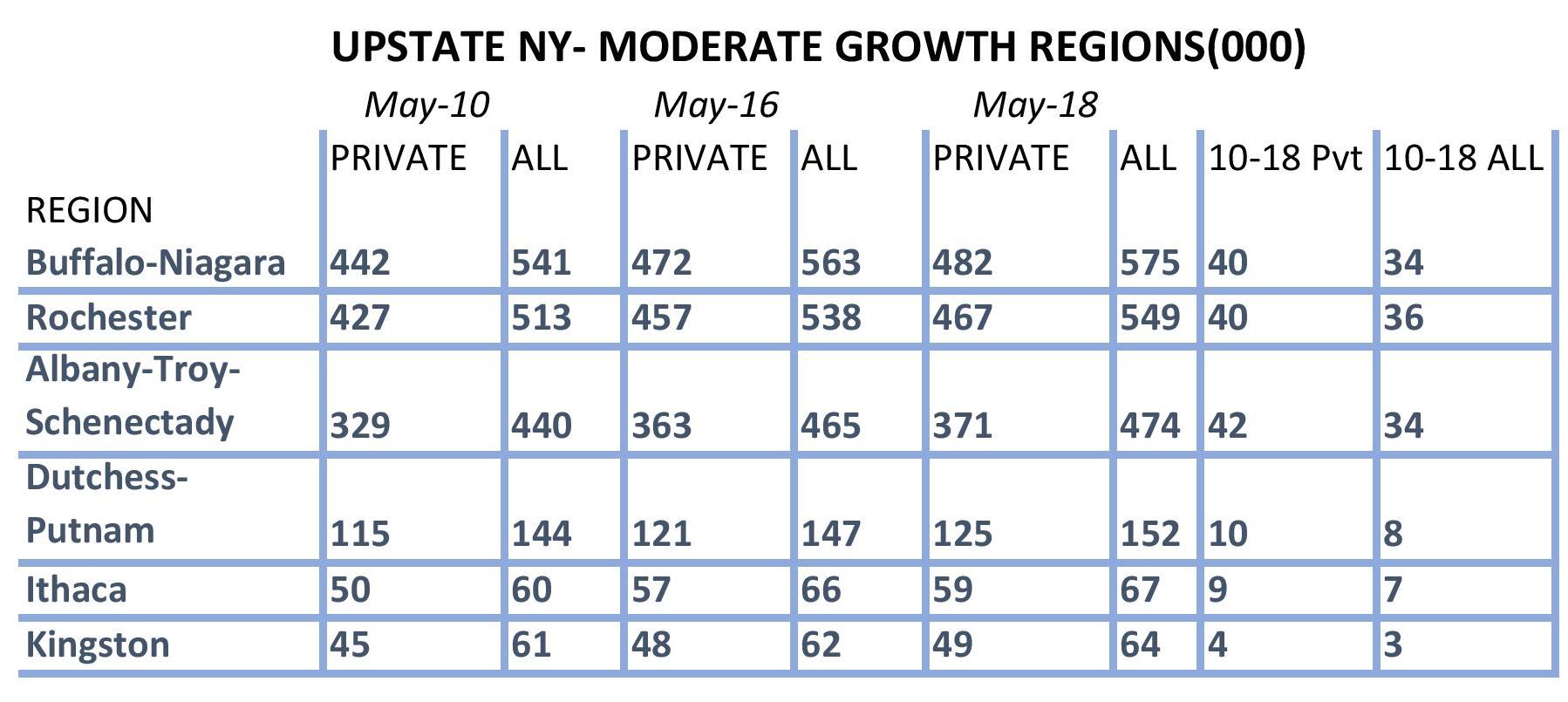
Upstate’s three largest metropolitan regions, the Buffalo-Niagara area, the Rochester area, and the Albany metro area, achieved 9-13% private sector employment growth in the eight years from May 2010 to May 2018. Dutchess-Putnam and Kingston had similar 9% private sector growth over the period, and Ithaca is the fastest-growing metro area Upstate. The six metro areas are nearly 60% of the 3 million job employment base and in these areas private sector jobs have been growing at more than 1% a year -- not as good as Downstate New York or the nation, but sustained improvement.
The next two tables show data for two slow-growth regions, four static/no-growth metro areas, and the third sums up the data for the 12 Upstate metro areas.
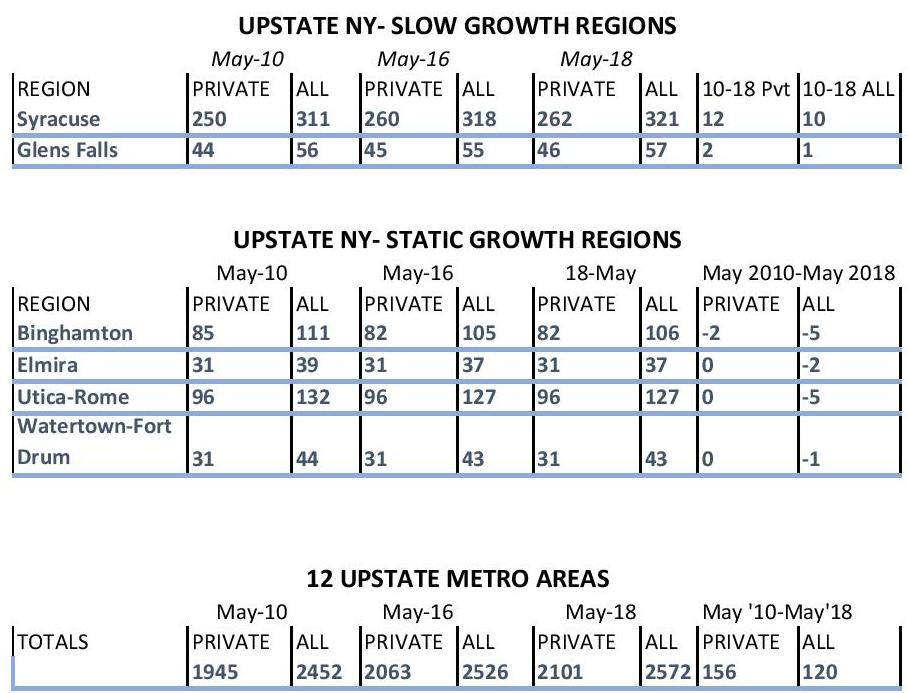
The Syracuse and Glens Falls metro areas were placed in a slow-growth category -- they achieved 4-5% private sector growth over eight years (even slower once the public sector jobs are included). There are four Upstate metro areas -- Binghamton, Elmira, Utica-Rome, and Watertown-Fort Drum -- where no private sector growth is occurring. These four areas are about 10% of the employment base of Upstate New York.
The number of jobs in non-metro areas of Upstate New York is about 500,000, about 16% of the employment base. Consistent data over the eight-year period for non-metro areas is difficult to elicit. Labor Department press releases that include non-metro growth don’t go back past 2015, so the best numbers from that source, from December 2013 to December 2017, showed growth of 4,000 jobs. My best estimation is that non-metro areas are in the slow growth category.
This portrait does not attempt to correlate direct state government investments, frequently in partnership with private companies, to create or preserve jobs, or the general allocation of state government resources, with these trends. The employment numbers are just the general trends -- and Upstate New York’s problems include population loss in some areas, like Central New York and the Southern Tier, where five of the six metro areas with slow or static growth are located. State government can also be making investments in jobs that are worthwhile individually in areas of population loss, but which do not show up in the aggregate data. Over the past seven years state government also embarked upon a broad general policy of making the state economy more competitive by cutting personal income, corporate income, and property taxes.
Empire State Development, state government’s economic development arm, finally produced a comprehensive report on its activities this year (mandated by law), and it does contain much information. Watchdogs criticized it for lacking metrics, meaning measurements of the effectiveness of the state’s investments against some set of standards. The accountability and effectiveness of the state’s resource-allocation remain the subject of another future column.
Governor Cuomo was right to say that helping an economy battered repeatedly by job losses before his tenure began is a major challenge, even if it wasn’t accurate to suggest that there was a 50-year downward path. Efforts to grow the Upstate economy seem to be modestly, but not highly, successful, although state government alone cannot determine economic destiny. How to frame this modest success in an election won’t be easy.
***
Jim Brennan was a member of the New York State Assembly for 32 years, where he chaired four committees. On Twitter @JimBrennanNY.
***
Have an op-ed idea or submission for Gotham Gazette? Email This email address is being protected from spambots. You need JavaScript enabled to view it.
Making the Libertarian Party Viable in New York City

(photo: Benjamin Kanter/Mayoral Photo Office)
New Yorkers are constantly complaining about the two-party political system. Democratic domination of New York City politics means Democratic primary elections are more impactful than general elections. Republican domination of the national political system means New Yorkers’ progressive cultural values are rarely reflected in national politics. At the state level, Democrats and Republicans seem to have a stable alliance built on maintaining one of the most corrupt state governments in the country.
Clearly the two largest political parties aren’t working for us, so what about the third: the Libertarian Party, which is has over 500,000 members nationwide? The Libertarian Party is more than twice the size of the fourth largest party, the Green Party, and more than 10 times the size the Democratic Socialists of America. Around 20% of Americans self-identify as “libertarian.”
The strength of the National Libertarian Party and the popularity of libertarian sentiment is not reflected in New York politics, where the Libertarian Party has failed to achieve official party status, which requires getting 50,000 votes for its gubernatorial candidate. While it’s likely that Larry Sharpe’s gubernatorial campaign will earn the New York Libertarian Party official status this election cycle, the size of party in New York City will still be miniscule, at around 100 dues-paying members (which is approximately .01 percent of self-identified libertarians).
The lack of Libertarians in New York City presents New Yorkers with a massive opportunity: to build a new local political party that can have instant national reach, national operational infrastructure, and a rapidly growing base of support in increasingly relevant western battleground states. This party wouldn’t and shouldn’t look like Libertarian parties in suburban and rural communities but something new: culturally progressive with a can-do, data-driven, startup-style, open-source attitude towards solving our city’s biggest problems. If the rural Libertarians think we’re not “real” Libertarians, then they can move to New York City and defeat us in county elections.
I don’t say this as an outsider, but as the chair of the Brooklyn Libertarian Party and the 2017 Libertarian candidate for New York City Public Advocate who earned more votes than any other Libertarian candidate in that city election cycle.
My plan for a relevant Libertarian Party in New York City rests on three concepts: social tolerance, open and participatory governance, and municipalism.
Each of these concepts is consistent with National Libertarian Party ideology and with the interests of urban voters. If we can fuse the two together, we can create a new political coalition to challenge the authoritarianism coming out of Washington, D.C. and the corruption pervading our two party system.
Social Tolerance
Many people think that libertarian culture and big city culture are at odds because libertarianism is so often framed as a philosophy rooted in rugged self-reliance and individual autonomy, but that’s mostly myth. In reality, libertarians are much more interested in well-functioning markets and how complex, interdependent systems produce so much abundance. If you don’t believe me, read “I, Pencil.”
New Yorkers know better than anyone that people can successfully organize themselves through market activity because that’s how our lives are possible. We rely on complex systems for everything: food, water, transit, employment. Yes, that means we also rely on government-produced systems, and that’s fine because the “big city libertarianism” I’m arguing for respects regional autonomy. More on that later.
The single, unifying, core principle of libertarianism is that individuals should be free to do as they please as long as they don’t harm others. Sometimes this is called the non-aggression principle. Other times it’s referred to as just plain old “tolerance and acceptance.” New Yorkers embody this spirit more than any other place I’ve been in America. We love diversity and it’s myriad of benefits. We also can tolerate crowded, sweaty trains filled with strangers from all over world, and we’re constantly teaching visitors and new residents to do the same. That’s what becoming a New Yorker is all about: learning tolerance for (and even love of) diverse lifestyles, races, genders, ethnicities, cultures, philosophies, religions, et al, -- because if we don’t have it our cities simply couldn’t function.
Everyone is tolerant when it’s popular, but people are surprised to learn that, at a national level, the Libertarian Party has walked the walk: nominating the first female presidential candidate in the 1970s, supporting gay rights in the 1980s, leading the fight against the drug war and mass incarceration in the 1990s, and opposing the war in Iraq in the 2000s, Obama’s drone wars in the 2010s, and Trump immigration policies today. The New York City Libertarians can and should lead on issues of mass incarceration and police militarization, and offer something no political party has yet -- a powerful solution: ending the drug war.
Open and Participatory Governance
Our political and governmental operating systems are outdated, and need to be redeveloped for the era of the internet. Both the Democrats and the Republicans are too invested in the old system to be able to produce any substantial reforms. If we look around globally, we’ll find that some of the most aggressive and successful reforms came from the Occupy-style movements that spread throughout the world around 2010-2014. While Occupy was framed as a leftist movement in the United States, in other places it was much more obviously an anti-corruption movement that used anarchist organizing principles. In many places alumni of these movements have taken power.
Examples include Madrid, where movement activists won elections and embedded themselves in the city government and implemented an ambitious e-governance system that enables the public to control the legislature through a direct-democracy style app. Another example is in Taiwan, where activists took over the national parliament for a month during the “Sunflower” movement, won concessions from the government, and have implemented a nationwide participatory democracy program that is the envy of the world.
What these movements have shown is that there are solutions to the question of democracy: but those solutions will destroy the politics of patronage, where politicians acquire resources from taxpayers and distribute them to their constituents, and instead require a politics of participation, where politicians use technology to convene stakeholders, determine public sentiment and then perform the will of the people, even if that means suppressing their own opinions and interests. That’s a different job description for which many existing politicians would not apply.
The other major trend in internet-enabled government is the spread of “digital services organizations” and their uniquely effective method of bureaucracy reform. By using open source technologies, lean development principles, service design methodologies and other “startup-style” tools, DSOs are implementing technical systems that will, ultimately, radically transform how government is administered: reduce the need for certain types of skill sets, automating processes and making services faster, better, and cheaper.
The political establishment and agency bureaucracies have been extremely hesitant to resource these DSOs because their work is shifting power from closed bureaucracies to open systems. As such, neither establishment party can give DSOs the support they deserve. But Libertarians can! We want government to operate faster, better and cheaper -- and if that means government workers lose their jobs in the process, that’s fine. Give them a universal basic income and let's move on.
 Municipalism
Municipalism
With Trump as president, many city residents have awoken to the fact that there are many layers of government -- and these various layers don’t always agree or collaborate with each other. They’re realizing that they’d much prefer a structure where the federal government has less power and municipal governments have a lot more. This “municipalism” is entirely consistent with libertarianism for two reasons. First, it localizes power and decreases the number of people each politician represents, making politicians and government more accountable. Second, it reduces the size and scope of the federal government, which is something every Libertarian supports.
By advocating at the national level for more local control, we align ourselves with a political program that spans the nation: urban and rural, progressive and conservative. Local control shouldn’t simply mean more policies are determined at local levels (although this is obviously a part of it), but should result in restructuring the tax system to shift the destination of tax revenue from the federal government to state and local governments.
I call this “flipping the pyramid.”
Currently, the federal government gets most of the tax money, then states, and lastly municipalities. This status quo should be flipped on its head so that the federal government receives the least amount of tax revenue, allowing states and local governments to gain significantly more.
In circumstances where rural and suburban communities don’t want or need big local governments, they will pay significantly lower taxes. Meanwhile, people in cities who do want lots of government services can increase their local taxes to pay for those services, without increasing the total amount of taxes they pay. Don’t want to pay taxes? Leave the city! This act of voting with one's feet is the oldest type of democracy, and the idea that people should actually get up and move from places that don’t share their values to places that do should be embraced (and maybe even subsidized).
We’ve seen what happens when we try a “one-size-fits all” model of federal policy: Washington, D.C. has been gridlocked for over a decade, the culture war is nastier than ever, Donald Trump is president, and it seems only the mega-rich are getting what they want from the political process. Instead, let’s allow for the “regional differentiation” that will naturally arise when localities have more power to determine their overall tax rate.
Maybe some cities will become hotbeds of socialist policy, and some rural communities will devolve into total anarchy. While that might sound drastic or raise the spectre of places becoming truly inhospitable to certain types of people in ways that they currently are not, we should recognize that (a) this process is already well underway for middle and upper class people who can afford to move, (b) our nation’s structural resistance to regional differentiation has led to our current political climate and (c) this approach will encourage and incentivize politically-minded people to shift their attention from the national political circus and get involved in local and state politics.
I am not advocating for the federal government to stop performing any of its constitutionally mandated or critical functions such as upholding the civil and human rights of U.S. citizens, investigating corruption of state and local officials, regulating interstate commerce, helping with disaster relief, and organizing national defense.
Rather, I’m advocating for a visioning process where we redraw the appropriate scope of local, city, regional, state, and federal powers.
While working to implement this new vision, we should also be investing our time and resources into upgrading the capacities of local, state, and regional governments so they’ll be able to absorb new responsibilities. Anyone involved with local politics knows that it can be just as corrupt as national politics, if not more so. That’s why our strategy must also include a movement to transform local governments into open, transparent and participatory institutions that good people want to lead. We can have that battle on our home turf instead of D.C.
New Yorkers, and urban residents throughout the country, deserve a culturally progressive, entrepreneur-friendly, open-source political party, and the Libertarian Party can be just that. There are no Libertarians in New York City interested in stopping us. I’m the chair of the Brooklyn Party, we’re collaborating actively with the Manhattan Party, and this weekend we’ll be taking our plan to the Libertarian National Convention in New Orleans to find allies and develop a more nuanced understanding of potential opposition to our plans.
In politics, opportunities can come from where you least expect them: maybe that’s the Libertarian Party in America’s big cities. Come find out by attending our monthly meeting in Brooklyn and the meetings of other chapters around the city.
***
Devin Balkind is the chair of the Brooklyn Libertarian Party. He was the 2017 Libertarian candidate for Public Advocate. On Twitter @DevinBalkind.
***
Have an op-ed idea or submission for Gotham Gazette? Email This email address is being protected from spambots. You need JavaScript enabled to view it.




